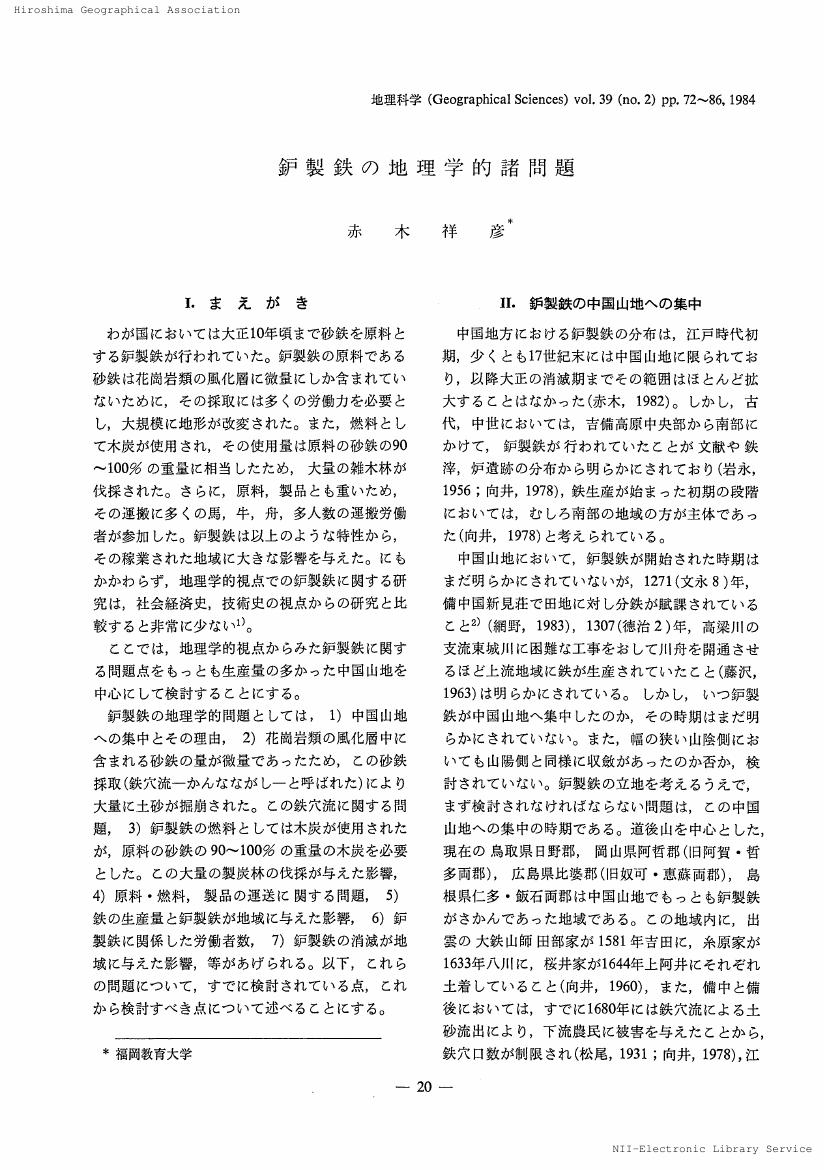1 0 0 0 OA 中国山地のペディメント
- 著者
- 赤木 祥彦
- 出版者
- The Association of Japanese Geographers
- 雑誌
- 地理学評論 (ISSN:00167444)
- 巻号頁・発行日
- vol.34, no.2, pp.55-67, 1961-02-01 (Released:2008-12-24)
- 参考文献数
- 48
- 被引用文献数
- 4 1
中国山地に発達しているペディメントのうち, 3段の侵蝕平坦面の境に発達しているそれにっいて検討したが,結果は次のようである. (1) ペディメントは比高のある崖の前面で,しかもペディメントの部分が花崗岩類で構成されており,背後急斜面の頂上部,あるいは大部分が硬岩層で構成されている所に発達しており,岩石の種類・配置によつて制約されている. (2) 背後急斜面とペディメントの間には傾斜の不連続部がある. (3) ほとんどのペディメントが小谷によつて開析されており,現在ではペディメントは発達していない. (4) ペディメント上はすべて角礫ないし亜角礫が花崗岩の風化土壌をマトリックスとして堆積しており,その中に不規則にシルト層が堆積していることがある. (5) ペディメントは急斜面が風化作用・重力の働き・雨水の働きにより後退してその概形が形成され,礫の移動によりさらに侵蝕されたと考えられる.礫の移動は主に重力の働きによるのではなく,流水の働きによつた. (6) ペディメント形成当時の気候はおそらく,現在より,より乾燥した気候であつたであろう.
- 著者
- 赤木 祥彦
- 出版者
- 歴史地理学会
- 雑誌
- 歴史地理学 (ISSN:03887464)
- 巻号頁・発行日
- vol.43, no.1, pp.4-19, 2001-01
1 0 0 0 OA 鈩製鉄の地理学的諸問題
- 著者
- 赤木 祥彦
- 出版者
- 地理科学学会
- 雑誌
- 地理科学 (ISSN:02864886)
- 巻号頁・発行日
- vol.39, no.2, pp.72-86, 1984 (Released:2017-04-20)
- 被引用文献数
- 1
1 0 0 0 OA 中国山地における鈩製鉄による地形改変土量と鉄生産量(下)
- 著者
- 赤木 祥彦
- 出版者
- 地理科学学会
- 雑誌
- 地理科学 (ISSN:02864886)
- 巻号頁・発行日
- vol.37, no.2, pp.85-102, 1982 (Released:2017-04-20)
- 被引用文献数
- 1
It is the purpose of this paper to estimate the amount of earth moved through Kannanagashi and the output of tatara in the Chugoku Mountains from historical data. In Japan iron was produced only by the traditional ironsand smelting method, tatara, until Western style smelting was introduced in 1853, and the tatara method continued to operate until the 1920s. The ironsand used as raw material is found in small quantities in weathered granitic rocks, it was collected by cutting weathered rocks and sorting in running water. This method of mining was known as kannanagashi. Spurs and hills in the Chugoku Mountains have been deformed by kannanagashi on a large scale as the quantities of ironsand found were small in proportion to the amount of earth moved. The amount of earth moved and the output of tatara can be estimated for the period of about 220 years from the beginning of the 18th century to the 1920s using the following factors: 1) the ratio of volume of iron sand collected to that of earth cut, 2) the volume of ironsand collected at one mine for one year, 3) the number of mines, 4) the ratio of iron sand used for tatara to output of tatara, 5) the volume of ironsand used for one tatara for one year, 6) the out put of one tatara for one year, and 7) the number of tatara. From the above calculations I conclude that the amount of earth moved was about 1,508 million m^3 and the output of tatara was about 2,660,000t.
1 0 0 0 陸前高田のPediment : 段丘による形成時期決定の一例
- 著者
- 赤木 祥彦
- 出版者
- 地理科学学会
- 雑誌
- 地理科学 (ISSN:02864886)
- 巻号頁・発行日
- vol.3, pp.17-20, 1964-09-01
